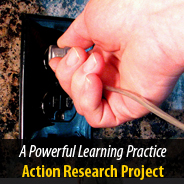How can we involve our students in authentic and connected learning experiences that will encourage collaboration with classmates, among grade levels, and with students from all over the world?
Students will…
- understand new ways to locate, use, and evaluate information to direct and support their own learning
- make connections between content and relevance to their lives
- relate content they’re learning with the needs/happenings of the community and global world
Our PLP team will…
- recognize the shifts in learning that are occurring and the impact of connected learning on our students and their lives
- devote themselves to professional growth by developing a personal learning network through the use of Twitter or other online communities
- through connected learning, incorporate the use of new technologies in the classroom
- examine their leadership impact and serve as lead learners in our school, modeling for other staff members technology integration/21st century teaching and learning
At the conclusion of our projects, we want students to be able to answer “Yes” to these questions, and demonstrate or explain how they met these criteria:
Did you experience authentic learning?
Learning is authentic when it….
- is relevant to students’ lives
- allows them to explore their interests
- helps them make connections between prior knowledge and new material
- requires application of knowledge and creation of a learning product
Did you experience connected learning?
Connected learning involves….
- students communicating with peers and adults to facilitate learning experiences, through face-to-face and virtual interactions
- students collaborating with others to achieve an end product
- students utilizing a variety of media to help access and evaluate information for use in learning
- students sharing their ideas with others
We will know the above objectives are achieved through classroom observations, student project work, assessment of students’ skills via rubric, and teacher surveys.
To pre-assess students’ levels of understanding and learning descriptors, teachers conducted student interviews. As the project began, student descriptor rubrics were developed using a tool from Learning Point Associations, North Central Regional Educational Laboratory (NCREL). This organization created an extended rubric for student performance based on ISTE’s NETS. Our resource was crafted based off of
this work.
The domains of the NETS*S/rubric on which we chose to focus:
- Social, Ethical, and Human Issues
- Technology Productivity Tools
- Technology Communication Tools
- Technology Research Tools
- Technology Problem-solving and Decision-making Tools
Click here to access the Student Descriptors Rubric
PLP team teachers assessed their students’ proficiency levels using the descriptors in the rubric in late April/early May. Results indicate that students’ proficiency levels have increased across the board. Graphical analysis of the data can be found on the Results page.
To evaluate the impact our PLP team had on professional practice in our building, Brecknock’s teachers were surveyed about their comfort with and use of various educational technologies this year compared to last year. Results indicate that teachers this year are more comfortable implementing new technologies in their classrooms. The frequency and types of technologies used have increased. Teachers look to our PLP teacher leaders for support and guidance in these areas.
The PLP team will be sharing the results and artifacts of their work this year with staff at a June faculty meeting. Lyn will be sharing the team’s efforts with administration. All PLP team members completed a personal reflection to share on the Reflections page.
Where do we go from here?
The teachers in our PLP cohort have developed into leaders in our school and inspire their colleagues to integrate technology into the curriculum and empower students to engage in self-directed, passion-driven learning opportunities. They provide encouragement and support to their peers and will continue to inspire new classrooms of students year after year.
We would like to include parents in the design of a more student-centered educational experience. This will involve evaluation of grading methods, investigation of student-led conferences, and inclusion of parents and community members in collaborative learning experiences with technology.


